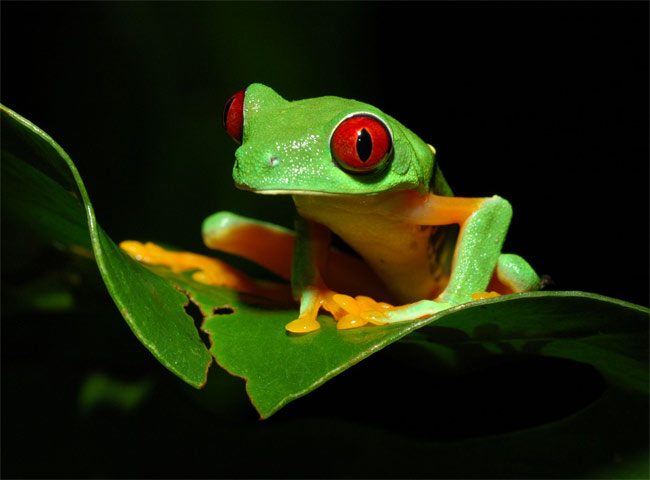Frog Shakes Its Booty to Deter Other Males

One species of male frog shakes its booty big-time in aggressive showdowns, with the victor pulsating its rear for longer and with more gusto.
The shaking, which starts with the hind end and becomes a whole-body affair, sends vibrations along the red-eyed treefrog's plant perch until the shaking reaches the frog's opponent sitting on the branch — this process is called tremulation.
"In the case of red-eyed treefrogs, tremulation displays in which the frogs shake their entire bodies convey information about the status and aggressive intent of the signaler," said researcher Michael Caldwell of Boston University. "They also appear to carry information about the size of the signaler."
Nighttime contests
Scientists had missed the waggling frogs because observations had taken place under white artificial light. "They're nocturnal, so you shine a light on them they say 'daytime,' or 'something is wrong here,'" Caldwell said. That kept the frogs from their normal booty-shaking routines.
But as soon as Caldwell and his colleagues went into the rainforests of Panama wielding infrared lights, the tremulations were apparent. Like other vertebrates, frogs can't see light at infrared wavelengths. When confronted with another male, the red-eyed treefrog (Agalychnis callidryas) extends its limbs so it's standing on all fours. Then, "it rapidly contracts and extends the hind limbs so its hind end shakes up and down," Caldwell said, "so basically shaking its butt." The effect is violent shaking of the frog's entire body.
The other male responds in kind. And both frogs in the matchup do so with consistency, at a frequency of 12 hertz or 12 times a second, the researchers found.
Get the world’s most fascinating discoveries delivered straight to your inbox.
After establishing that males do these tremulations, Caldwell and his colleagues staged in-the-field, nighttime contests between pairs of males and watched what happened under infrared light. Within minutes, video of the male frogs showed one male did the shake-shake to which the other male responded with his own aggressive butt-waggling.
The dominant males, those that were victors and remained at the calling site in wait for the "ladies," also tremulated for longer durations and more frequently overall, Caldwell found.
Robotic frogs
To figure out whether the frogs were responding to the vibrations traveling along the tree branch or to the visual display created when the male does this bodily shaking, the researchers built a robotic look-alike.
They placed the robotic frog on a plant perch near a real-life male. In some instances, this articulated puppet shook while a larger mechanical shaker made the tree branch vibrate; other scenarios involved just the shaking robot with no vibrations along the tree branch, while other setups, such as white noise or a still robot, were used as controls for comparison.
While both the visual and vibrational signals are likely important in male-male combat, the opponent frogs never tremulated in response to a scenario that didn't include the vibrations, such as when the frog shook but the branch didn't.
Working in the field did have its comic moments, such as "after some beautiful data everything is ruined when a female comes by and the male leaves the plant to chase her down," Caldwell told LiveScience. "It was a very live situation." And then there were mosquitoes, leeches and snakes … and a pesky bull ant that stung Caldwell, who still has a scar from the incident.
The findings in treefrogs are likely applicable to other arboreal vertebrates, such as other frogs, lizards, birds and primates, the researchers say.
"Studies on frogs, birds, and primates have formed the core of our understanding of vertebrate communication, yet we know almost nothing about vibrational signaling in these species," the researchers write in the May 20 issue of the journal Current Biology.
- Video - Shake, Shake, Shake: Frogs Tremor to Defend Turf
- Gallery: Bizarre Frogs, Lizards and Salamanders
- 10 Amazing Things You Didn't Know About Animals
Jeanna Bryner is managing editor of Scientific American. Previously she was editor in chief of Live Science and, prior to that, an editor at Scholastic's Science World magazine. Bryner has an English degree from Salisbury University, a master's degree in biogeochemistry and environmental sciences from the University of Maryland and a graduate science journalism degree from New York University. She has worked as a biologist in Florida, where she monitored wetlands and did field surveys for endangered species, including the gorgeous Florida Scrub Jay. She also received an ocean sciences journalism fellowship from the Woods Hole Oceanographic Institution. She is a firm believer that science is for everyone and that just about everything can be viewed through the lens of science.


